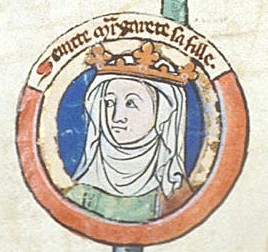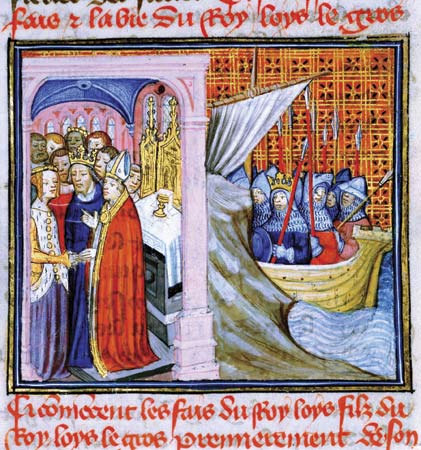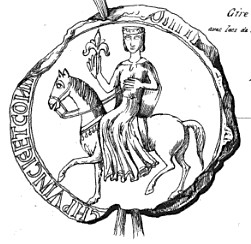|
Joan Of England, Queen Of Scots
Joan of England (22 July 1210 – 4 March 1238), was Queen consort of Scotland from 1221 until her death. She was the third child of John, King of England and Isabella of Angoulême. Life Joan was sought as a bride by Philip II of France for his son. In 1214, however, her father King John promised her in marriage to Hugh X of Lusignan, as compensation for his being jilted by her mother Isabella. She was promised Saintes, Saintonge and the Isle of Oléron as dowry, and was sent to her future spouse in that year to be brought up at his court until marriage. Hugh X laid claim on her dowry already prior to their marriage, but when this did not succeed, he reportedly became less eager to marry her. On the death of John of England in 1216, queen dowager Isabella decided she should marry Hugh X herself. Hugh X kept Joan with him in an attempt to keep her dowry as well as having the dowry of her mother Isabella released from the English. On 15 May 1220, after an intervention from th ... [...More Info...] [...Related Items...] OR: [Wikipedia] [Google] [Baidu] |
List Of Scottish Consorts
The consorts of the monarchs of Scotland bore titles derived from their marriage. The Kingdom of Scotland was first unified as a Sovereign state, state by Kenneth I of Scotland in 843, and ceased to exist as an independent kingdom after Act of Union 1707, the Act of Union 1707 when it was merged with the Kingdom of England to become the Kingdom of Great Britain. The early history of Scotland is confused and often obscure, due largely to information given by the sources of the time and after, which are often contradictory, vague, and lacking in detail. Details of the kings prior to Malcolm III are sparse, and the status of two – Giric of Scotland, Giric and Eochaid of Scotland, Eochaid – dubious; details of their wives are almost non-existent. Thus, it is practically impossible to construct a list of consorts of Scotland prior to the accession of Macbeth of Scotland, Macbeth, whose wife Gruoch of Scotland, Gruoch is well-documented and Lady Macbeth, somewhat notorious. House ... [...More Info...] [...Related Items...] OR: [Wikipedia] [Google] [Baidu] |
Henry III Of England
Henry III (1 October 1207 – 16 November 1272), also known as Henry of Winchester, was King of England, Lord of Ireland, and Duke of Aquitaine from 1216 until his death in 1272. The son of King John and Isabella of Angoulême, Henry assumed the throne when he was only nine in the middle of the First Barons' War. Cardinal Guala Bicchieri declared the war against the rebel barons to be a religious crusade and Henry's forces, led by William Marshal, defeated the rebels at the battles of Lincoln and Sandwich in 1217. Henry promised to abide by the Great Charter of 1225, a later version of the 1215 '' Magna Carta'', which limited royal power and protected the rights of the major barons. His early rule was dominated first by Hubert de Burgh and then Peter des Roches, who re-established royal authority after the war. In 1230, the King attempted to reconquer the provinces of France that had once belonged to his father, but the invasion was a debacle. A revolt led by William ... [...More Info...] [...Related Items...] OR: [Wikipedia] [Google] [Baidu] |
Matilda Of England
Empress Matilda ( 7 February 110210 September 1167), also known as the Empress Maude, was one of the claimants to the English throne during the civil war known as the Anarchy. The daughter of King Henry I of England, she moved to Germany as a child when she married the future Holy Roman Emperor Henry V. She travelled with her husband to Italy in 1116, was controversially crowned in St Peter's Basilica, and acted as the imperial regent in Italy. Matilda and Henry V had no children, and when he died in 1125, the imperial crown was claimed by his rival Lothair of Supplinburg. Matilda's younger and only full brother, William Adelin, died in the '' White Ship'' disaster of 1120, leaving Matilda's father and realm facing a potential succession crisis. On Emperor Henry V's death, Matilda was recalled to Normandy by her father, who arranged for her to marry Geoffrey of Anjou to form an alliance to protect his southern borders. Henry I had no further legitimate children and nominated ... [...More Info...] [...Related Items...] OR: [Wikipedia] [Google] [Baidu] |
Geoffrey V Of Anjou
Geoffrey V (24 August 1113 – 7 September 1151), called the Handsome, the Fair (french: link=no, le Bel) or Plantagenet, was the count of Anjou, Touraine and Maine by inheritance from 1129, and also Duke of Normandy by conquest from 1144. His marriage to Empress Matilda, daughter of King Henry I of England, led to the centuries-long reign of the Plantagenet dynasty in England. The name "Plantagenet" was taken from Geoffrey's epithet. Geoffrey's ancestral domain of Anjou gave rise to the name Angevin, and what modern historians name as the Angevin Empire in the 12th century. Early life Geoffrey was the elder son of Fulk V of Anjou and Ermengarde of Maine. Geoffrey received his nickname from the yellow sprig of broom blossom (''genêt'' is the French name for the ''planta genista'', or broom shrub) he wore in his hat. The chronicler John of Marmoutier described Geoffrey as handsome, red haired, jovial, and a great warrior. King Henry I of England, having heard reports o ... [...More Info...] [...Related Items...] OR: [Wikipedia] [Google] [Baidu] |
Alice Of Courtenay
Alice of Courtenay (french: Alix; 1160 – 12 February 1218) was a French noblewoman. Her father was Peter I of Courtenay and her brother was Peter II of Courtenay, Latin Emperor of Constantinople. Alice married twice; by her second husband, Count Aymer of Angoulême, she was the mother of the English queen Isabella of Angoulême. Family Alice was born in 1160, the second-eldest daughter and one of the ten children of Peter I of Courtenay and Elisabeth of Courtenay, daughter of Renauld de Courtenay and Hawise du Donjon. Her family was one of the most illustrious in France; and her paternal grandparents were King Louis VI of France and Adelaide of Maurienne. Her eldest brother Peter became the Latin emperor of Constantinople in 1216. She also had as cousins Philip Augustus, the King of France, Agnes, the Empress of the Byzantine Empire, and Margaret, the Queen of England, Hungary and Croatia. Alice's first husband was Andrew, lord of La Ferté-Gaucher, Champagne, whom she marrie ... [...More Info...] [...Related Items...] OR: [Wikipedia] [Google] [Baidu] |
Henry II Of England
Henry II (5 March 1133 – 6 July 1189), also known as Henry Curtmantle (french: link=no, Court-manteau), Henry FitzEmpress, or Henry Plantagenet, was King of England from 1154 until his death in 1189, and as such, was the first Angevin king of England. King Louis VII of France made him Duke of Normandy in 1150. Henry became Count of Anjou and Maine upon the death of his father, Count Geoffrey V, in 1151. His marriage in 1152 to Eleanor of Aquitaine, former spouse of Louis VII, made him Duke of Aquitaine. He became Count of Nantes by treaty in 1158. Before he was 40, he controlled England; large parts of Wales; the eastern half of Ireland; and the western half of France, an area that was later called the Angevin Empire. At various times, Henry also partially controlled Scotland and the Duchy of Brittany. Henry became politically involved by the age of 14 in the efforts of his mother Matilda, daughter of Henry I of England, to claim the English throne, then occupied b ... [...More Info...] [...Related Items...] OR: [Wikipedia] [Google] [Baidu] |
John Of England
John (24 December 1166 – 19 October 1216) was King of England from 1199 until his death in 1216. He lost the Duchy of Normandy and most of his other French lands to King Philip II of France, resulting in the collapse of the Angevin Empire and contributing to the subsequent growth in power of the French Capetian dynasty during the 13th century. The baronial revolt at the end of John's reign led to the sealing of , a document considered an early step in the evolution of the constitution of the United Kingdom. John was the youngest of the four surviving sons of King Henry II of England and Duchess Eleanor of Aquitaine. He was nicknamed John Lackland because he was not expected to inherit significant lands. He became Henry's favourite child following the failed revolt of 1173–1174 by his brothers Henry the Young King, Richard, and Geoffrey against the King. John was appointed Lord of Ireland in 1177 and given lands in England and on the continent. He unsuccessfully att ... [...More Info...] [...Related Items...] OR: [Wikipedia] [Google] [Baidu] |
English Reformation
The English Reformation took place in 16th-century England when the Church of England broke away from the authority of the pope and the Catholic Church. These events were part of the wider European Protestant Reformation, a religious and political movement that affected the practice of Christianity in Western Europe, Western and Central Europe. Ideologically, the groundwork for the Reformation was laid by Renaissance humanism, Renaissance humanists who believed that the Bible, Scriptures were the only source of Christian faith and criticized religious practices which they considered superstitious. By 1520, Martin Luther, Martin Luther's new ideas were known and debated in England, but Protestants were a religious minority and heretics under the law. The English Reformation began as more of a political affair than a theological dispute. In 1527, Henry VIII requested an annulment of his marriage, but Pope Clement VII refused. In response, the English Reformation Parliament, Refo ... [...More Info...] [...Related Items...] OR: [Wikipedia] [Google] [Baidu] |
Berengaria Of Navarre
Berengaria of Navarre ( eu, Berengela, es, Berenguela, french: Bérengère; 1165–1170 – 23 December 1230) was Queen of England as the wife of Richard I of England. She was the eldest daughter of Sancho VI of Navarre and Sancha of Castile. As is the case with many of the medieval English queens, little is known of her life. Traditionally known as "the only English queen never to set foot in the country", she may in fact have visited England after her husband's death, but did not do so before, nor did she see much of Richard during her marriage, which was childless. She did (unusually for the wife of a crusader) accompany him on the start of the Third Crusade, but mostly lived in his French possessions, where she gave generously to the church, despite difficulties in collecting the pension she was due from Richard's brother and successor John after she became a widow. Early years In 1185, Berengaria was given the fief of Monreal by her father. Eleanor of Aquitaine p ... [...More Info...] [...Related Items...] OR: [Wikipedia] [Google] [Baidu] |
Eleanor Of Aquitaine
Eleanor ( – 1 April 1204; french: Aliénor d'Aquitaine, ) was Queen of France from 1137 to 1152 as the wife of King Louis VII, Queen of England from 1154 to 1189 as the wife of King Henry II, and Duchess of Aquitaine in her own right from 1137 until her death in 1204. As the heiress of the House of Poitiers, which controlled much of southwestern France, she was one of the wealthiest and most powerful women in western Europe during the High Middle Ages. She was a patron of poets such as Wace, Benoît de Sainte-Maure, and Bernart de Ventadorn. She was a key leading figure in the unsuccessful Second Crusade. Eleanor was the daughter of William X, Duke of Aquitaine, and Aénor de Châtellerault. She became duchess upon her father's death in April 1137, and three months later she married Louis, son of her guardian King Louis VI of France. A few weeks later, Eleanor's father-in-law died and her husband succeeded him as King Louis VII. Eleanor and Louis VII had two daughters, M ... [...More Info...] [...Related Items...] OR: [Wikipedia] [Google] [Baidu] |
Richard, 1st Earl Of Cornwall
Richard (5 January 1209 – 2 April 1272) was an English prince who was King of the Romans from 1257 until his death in 1272. He was the second son of John, King of England, and Isabella, Countess of Angoulême. Richard was nominal Count of Poitou from 1225 to 1243, and he also held the title Earl of Cornwall from 1225. He was one of the wealthiest men in Europe and joined the Barons' Crusade, where he achieved success as a negotiator for the release of prisoners and assisted with the building of the citadel in Ashkelon, Ascalon. Biography Early life He was born 5 January 1209 at Winchester Castle, the second son of John, King of England, and Isabella, Countess of Angoulême. He was made High Sheriff of Berkshire at age eight, was styled Count of Poitou from 1225 and in the same year, at the age of sixteen, his brother Henry III of England, King Henry III gave him Cornwall as a birthday present, making him High Sheriff of Cornwall. Richard's revenues from Cornwall helped make hi ... [...More Info...] [...Related Items...] OR: [Wikipedia] [Google] [Baidu] |








